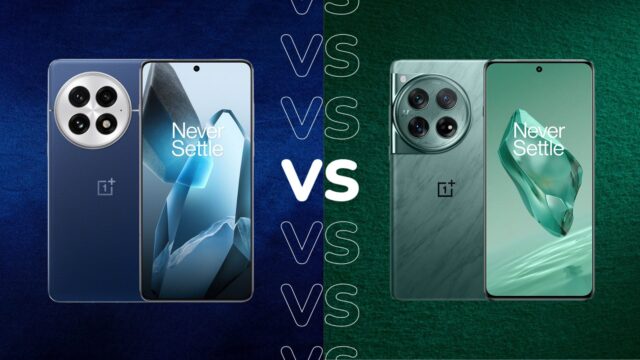Following its release in China in late 2024, the OnePlus 13 has finally had its international debut, headed to the UK, US and Europe – but how does it stack up compared to its popular predecessor, the OnePlus 12?
While you can certainly tell that the two smartphones come from the same family at a glance, there are several key differences between the two flagship smartphones that could sway your vote one way or the other, not only when it comes to performance but also elements like battery life and even camera performance.
With that said, here’s how the OnePlus 13 compares to the OnePlus 12, highlighting the key differences between the two flagship smartphones.
Pricing & availability
The OnePlus 13 comes in starting at £899 with 256GB of storage, while the top-end 512GB variant comes in at a cool £999, and it’s available to buy right now.
That’s £50 more than the £849 of the 256GB OnePlus 12 at launch this time last year, though the 512GB matches the 13’s £999 price tag – though with the caveat that with the launch of the OnePlus 13, the OnePlus 12 will likely drop in price as retailers try to shift the remaining stock.
The OnePlus 13 is much more powerful
Though the OnePlus 12’s Snapdragon 8 Gen 3 delivered a smooth everyday experience, it can’t quite compete with what the OnePlus 13 offers. OnePlus’ new flagship sports the Snapdragon 8 Elite, and that’s a bigger deal than you might expect.
Sure, newer chipsets are always more powerful than their predecessors, but the Oryon CPU-based Snapdragon 8 Elite offers a massive jump in terms of YOY performance, with a 45% boost to CPU speeds, 40% in the GPU department and 45% when it comes to the NPU, all while being up to 45% more efficient.

That’s borne out in benchmark tests too, with the OnePlus 13 offering scores of 9494 in the CPU-focused Geekbench 6 multi-core test, almost double that of the OnePlus 12’s 5054. Essentially, the OnePlus 13 is more powerful and drains less battery than the OnePlus 12.
The OnePlus 13 has a refreshed, more durable design
Though you can certainly tell that the OnePlus 13 is the successor to the OnePlus 12 at a quick glance, there are a handful of changes to this year’s flagship.
The most immediately noticeable upon picking up the 6.8-inch smartphone will be the changes to the frame; it’s now flat, much like you’d get from an iPhone 16 or Samsung Galaxy S24, ditching the curved edges of its predecessor for a cleaner, more robust look.


It’s also thinner and lighter than the OnePlus 12, measuring in at 8.5mm and 210g compared to 9.2mm and 220g, though it’s not a massive difference overall.
What’s more impressive is the smartphone’s upgraded durability; while the OnePlus 12 already had top-end IP68 protection, the OnePlus 13 ups that to IP68/69, essentially protecting it against hot jets of water as well as being able to survive a dunk in fresh water.
Coupled with the company’s Aqua Touch tech that makes it way easier to use the phone when it’s wet, the OnePlus 13 should keep chugging along no matter the weather.
The OnePlus 13 has a larger battery
Following a general trend in the smartphone industry over the past few months, the OnePlus 13 has a massively upgraded battery with a whopping 6000mAh capacity, a decent 600mAh increase compared to the 5400mAh cell of the OnePlus 12.
Coupled with the improved power efficiency of the Snapdragon 8 Elite, the OnePlus 13 delivers a solid upgrade on overall battery life, though with a high-res 6.8-inch screen to power, it’s still not a phone that’ll last for days on end.


When it comes to charging, expect the same 100W charging (or 80W in the US) as the OnePlus 12, alongside 50W wireless charging. There’s also a new case for the OnePlus 13 with built-in magnets and a new magnetic wireless charger to go along with it, though these are both optional accessories.
The OnePlus 12 has a higher-res telephoto camera
The OnePlus 12 and OnePlus 13 both have the same combination of main, ultrawide and 3x telephoto lenses, though there are a handful of differences between the two.
The most apparent difference is in the telephoto department, with the OnePlus 12 offering a higher-res 64MP snapper than the 50MP option on the OnePlus 13. The OnePlus 13’s sensor is a fraction bigger than the OnePlus 12 which could help to negate any differences in real-world performance, however.


Elsewhere, the main 50MP sensor remains practically unchanged, once again sporting a 1/1.43-inch sensor with OIS and an f/1.6 aperture. At the same time, the 48MP f/2.2 ultrawide of the OnePlus 12 has had a marginal upgrade to 50MP f/2.0 on the OnePlus 13.
The OnePlus 13 continues the brand’s collaboration with photography powerhouse Hasselblad, bringing with it a handful of Hasselblad-co-developed shooting modes and features to help stylise the shots you take on your phone. Still, there’s nothing new here compared to the OnePlus 12.
The OnePlus 13 has boosted AI capabilities
The OnePlus 13 ships with the company’s latest software in the form of OxygenOS 15 based on Android 15, and with it comes a handful of new AI features exclusive to the latest flagship.
The highlight of the new AI features is Intelligent Search, which essentially allows the phone to search through local files and answer natural language questions based solely on the info it finds. It allows you to ask questions like ‘how much is my phone bill’ if you’ve got your most recent phone bill stored on your phone.
Crucially, however, this will only work with files stored directly on your phone; there’s no integration with cloud services like Dropbox or Google Drive here.


There are also live translation capabilities, working in real-time as you speak rather than translating once you’ve finished your sentence as with other AI-based translation services. It’ll support 20+ languages at launch, though that’s not until sometime in February.
OxygenOS 15 also comes with a host of AI photo editing features, AI Notes that lets you format, summarise, change tone and more, AI Reply that understands the context of your conversation and provides pre-written replies and, of course, Circle to Search support.
However, these are all also available on the OnePlus 12. It’s only Intelligent Search and Live Translation that are exclusive to the OnePlus 13.
Early thoughts
The OnePlus 13 is undoubtedly the better phone out of the two, offering not only an improved, more durable design but top-end performance from the Snapdragon 8 Elite, a bigger battery, improved AI smarts and more – but these are arguably only minor updates compared to the still-impressive OnePlus 12.
As such, there may not be enough here for existing OnePlus 12 owners to upgrade, though if you’re coming from an older phone, the OnePlus 13 looks like the one to go for.









